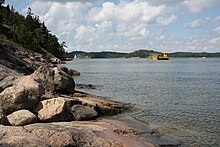This article is written like a travel guide. (September 2020) |
Nagu
Nagu – Nauvo | |
|---|---|
Former municipality | |
| Nagu kommun Nauvon kunta | |
 Location of Nagu in Finland | |
| Coordinates: 60°11′35″N 021°54′25″E / 60.19306°N 21.90694°E | |
| Country | Finland |
| Region | Southwest Finland |
| Consolidated | 2009 |
| Area | |
| • Total | 1,698.44 km2 (655.77 sq mi) |
| • Land | 246.88 km2 (95.32 sq mi) |
| • Water | 1,451.56 km2 (560.45 sq mi) |
| Population (2008-12-31)[2] | |
| • Total | 1,428 |
| • Density | 0.84/km2 (2.2/sq mi) |
| Time zone | UTC+2 (EET) |
| • Summer (DST) | UTC+3 (EEST) |

Nagu (Finland Swedish: [ˈnɑːɡʉ] ; Finnish: Nauvo [ˈnɑu̯ʋo]) is a former municipality and parish of Finland. On 1 January 2009, it was consolidated with Houtskär, Iniö, Korpo and Pargas to form the new town of Väståboland. On 1 January 2012 the name Väståboland was changed to Pargas.
Nagu consists of two main islands (Lillandet and Storlandet) and 1500–3000 smaller islands and skerries located south of Turku in the province of Western Finland in the region of Southwest Finland. The Nagu archipelago is part of the world's largest brackish water archipelago with 100 000 islands, islets and skerries in Sweden, Finland and Estonia. The total area of Nagu is 1 698,44 km2, of which the land area is only 246.88 km2 (95.32 sq mi),[1] or less than 15%.
Nagu has a population of approximately 1 400 persons, but during the summer over 10 000 more reside in the area.[3]
Most of the islands belonging to the Nagu archipelago can be reached by a network of roads, bridges and cost-free connection boats covering the vast archipelago area and reaching also the most remote islands in the south, where Nagu shares borders with the international waters of the Baltic sea.
- ^ a b "Area by municipality as of 1 January 2008" (PDF) (in Finnish and Swedish). Land Survey of Finland. Archived from the original (PDF) on 2011-08-07. Retrieved 27 March 2010.
- ^ "Population by municipality as of 31 December 2008". Population Information System (in Finnish and Swedish). Population Register Center of Finland. Archived from the original on 2010-12-02. Retrieved 27 March 2010.
- ^ Oy, Ch5 Finland; www.ch5finland.com, Ch5 Finland Oy-. "Kort om Nagu". www.pargas.fi (in Swedish). Archived from the original on 2019-10-24. Retrieved 2019-02-11.
{{cite web}}: CS1 maint: numeric names: authors list (link)
